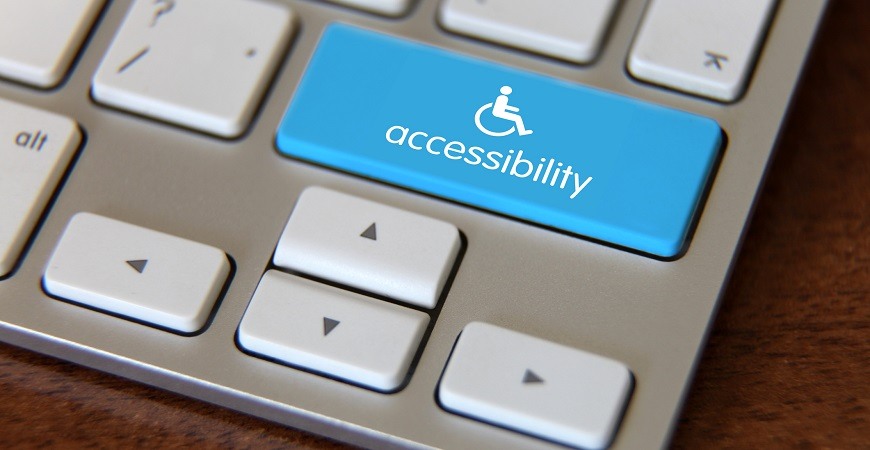Web Accessibility 101: The Basics

Making website content accessible is important to reach your largest potential audience and for compliance. Learn how you can easily make your site development more accessible.
Chances are you have heard of web accessibility. But what’s the hype all about? I’m here to walk you through Web Accessibility 101: The Basics.
What is Web Accessibility and Why is it Important Now?
Web accessibility refers to the inclusive practice of making websites usable by people of all abilities and disabilities. When making design choices about layout, colors and interactivity, keep in mind the needs of your users.
Know User Needs
1 in 5 people are estimated to live with a disability (about 1.5 billion people)—with a combined disposable income of more than $1.2 trillion. Common differences to consider include:
|
Vision |
The World Health Organization (WHO) estimates 285 million people worldwide are visually impaired with blindness and low vision. The National Eye Institute reports color blindness affects approximately 1 in 12 men and 1 in 200 women. |
|
Movement |
The Centers for Disease Control and Prevention (CDC) estimates more than 54 million people have arthritis, and 8 million working-age adults report their ability to work is limited due to arthritis. |
|
Hearing |
Disabling hearing loss affects 360 million people worldwide, according to the WHO. Hearing loss increases as we age, so this number continues to grow as the population ages. |
|
Thinking |
According to the National Center for Learning Disabilities, learning and attention issues, such as dyslexia and ADHD, affect 1 in 5 children in the U.S, and millions of children are not formally identified. Neurological disabilities, including epilepsy, affect nearly one billion people worldwide. |
|
Temporary |
Most people experience disabling situations from time to time, whether it’s a noisy environment, bright or dim lighting, or physical limitations like a broken arm. |
Assistive Devices for Users
When optimizing your website to accommodate users with disabilities, it’s important to understand what kind of issues they may encounter depending on the type of assistive technology they may be using.
Assistive technology devices increase, maintain, or improve functional capabilities of individuals with disabilities, so it is important to keep these devices in mind. Examples of these devices include:
|
Keyboards |
With over 400 types of keyboards available, users with many types of disabilities have a lot of options for navigating without using a mouse. |
|
Braille Display |
Braille users can read computer screens thanks to refreshable displays. |
|
Screen Readers |
Screen readers interact with webpages and applications to read semantic content to the user. |
|
Screen Magnifier |
Software that enlarges the content displayed on a screen to make it easier for users with low vision to see it. |
|
Voice Recognition |
Software, like Siri and Alexa, helps users dictate text and control their computers with their voice. |
For example, when a site is properly formatted, a user can quickly navigate through keyboard commands to common page elements the same way sighted users can visually see sections of a page.
How Do I Measure Accessibility?
WCAG 2.0 (Web Content Accessibility Guidelines 2.0) defines how to make web content more accessible to people with disabilities. The guidelines are internationally recognized and are used as a best practice worldwide. WCAG has 12 guidelines organized under four principles:
- Perceivable: Web content can be perceived by the user’s brain regardless of the senses they can use
- Operable: Web content can be accessed and navigated regardless of the user’s devices
- Understandable: Web content can be understood as easily as possible through simple language and contextual information
- Robust: Web content can be accessed regardless of the user’s operating system or browser
The success criteria fall under Level A, Level AA, or Level AAA. Level A and Level AA have been adopted by various international standards and legal requirements.
Download Siteimprove’s infographic and walk through a visual journey of learning what web accessibility is, who it affects, and what the benefits are.
Who is Responsible for Accessibility?
Dividing ownership and establishing responsibilities is crucial. It helps to have an accessibility coordinator or a go-to person who is consulted when questions or decisions arise. These could involve general accessibility knowledge, re-structuring, new purchases and integration, change of existing policies and more.
|
Content Editors |
The content creator added an image but may not have known how to add alternative text for the image or known that it was required. |
|
Designer |
This role is responsible for creating images and icons that have sufficient color contrast and need to be aware which combinations don’t work. |
|
Developer |
The developer used icons for functions on the page but didn’t include accessibility markup/code. |
|
Procurement |
The purchaser bought a software product, like a content management system, that didn’t include accessibility features that could have avoided this error. |
|
Leadership |
Leadership did not make accessibility a priority by requiring everyone to attend training and know their role as related to accessibility. |
Dividing ownership and establishing responsibilities is crucial. It helps to have an accessibility coordinator or a subject matter expert who is consulted when questions arise. Accessibility touches communications, human resources, purchasing and project management.
Download Siteimprove’s Must-Have Accessibility Handbook for more information about roles and responsibilities on the road to compliance.
How Do I Get Started?
Create a strategy that incorporates accessibility across the organization. Explore your current environment to gather information for your business case and begin building your accessibility plan.
- Create a baseline and inventory your digital environment to know where you stand
- Integrate accessibility into organizational policies and procedures
- Track progress toward becoming accessible
- Identify key stakeholders and define goals and timelines
- Plan to educate and train staff on accessibility
If you’re not sure where to start—Siteimprove can help. We have a team of experienced accessibility consultants who can provide guidance.
Resources
Siteimprove’s Accessibility Chrome Checker: This free extension allows you to access the Siteimprove platform to evaluate any web page for accessibility issues at any given time. It provides intuitive, visual feedback about your content by highlighting detected issues right on the page.
Siteimprove’s Sitefinity Extension: Siteimprove now has an extension for the Sitefinity CMS! Web teams can now access Siteimprove’s actionable insights directly within the Sitefinity CMS, streamlining efficiencies to work toward accessibility compliance.
Learn More: Wednesday, May 30th at ProgressNEXT
Attend my session at Progress NEXT 2018 on Incorporating Accessibility into Site Development.
As many developers know, accessibility should be top of mind when building website templates. This includes site navigation, CSS elements, form building, and more. will walk you through how to make these components accessible using Kendo UI, ARIA, and JavaScript. Attend this session to learn how to make accessibility a top priority in site development. View the full ProgressNEXT agenda here.
Key Takeaways:
- Leverage software to manage accessibility compliance
- Learn how to build accessible forms for all users
- Address keyboard and mouse functionality
If you’re attending Progress NEXT and want to learn more about Siteimprove, be sure to stop by the Siteimprove booth in the sponsor area, or attend the Siteimprove Happy Hour on May 30th, from 5:30pm – 9pm in the Harbor Ballroom.

